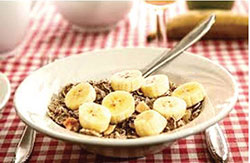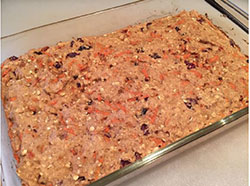Choosing Breakfast Cereals
Glenda Wentworth, Family & Consumer Science Extension Agent, Eagle County

Do you serve your child ready-to-eat cereal for a quick and easy breakfast? Cereals can be a convenient and nutritious way to start the day. Many cereals are fortified with beneficial vitamins and minerals. However, many cereals are also loaded with sugar and provide little to
no fiber. Cereals can also be highly processed.
For a healthy option, look for and offer children cereals that have less than 6 grams of sugar per serving and that provide at least 2.5 grams of fiber per serving. Cereals containing nuts will be higher in protein and fat. However, the fat from nuts is a healthy fat that can help you feel full longer than a cereal that is mostly carbohydrates.
Pay attention to the Nutrition Facts label and skip the health claims on the front of a package.
The front of the packaging is where the marketing is. A serving of cereal can vary from ½ cup
to more than a cup. For a visual, use a measuring cup to see what the actual serving size is.
Try to stick to the recommended serving size. Generally, a one-ounce serving should contain
100 – 200 calories.
Sometimes it is easier to gradually reduce the amount of sugar sweetened cereal by mixing it
with similar looking low-sugar cereals. Gradually increase the amount of low-sugar cereal
over time to get children used to them. As an alternative, at the store, allow your child to pick
from a selection of two to three healthier cereals that are lower in sugar and contain more
whole grains.
Grabbing a serving of dry cereal, a whole piece of fruit and a carton of low-fat milk provides a
quick, easy, and healthy way to start your and your child’s day.
Let’s Talk
Cereal companies have increased advertising to children. Cereal boxes are designed
to attract children’s attention. There is a strategy involved in the placement of cereal
on the grocery shelf. Talk to your children about how the sweeter cereals are placed
on the lower shelfs at their eye level to entice them into wanting that cereal. More
expensive cereal brands are at “eye-level”. That makes them easy to see and easy to
grab. Have a “Cereal Box Design Contest” with your children. Allow them to create a
cereal box for their favorite cereal. Then have family or friends judge the boxes.
Recipes for Health:
Power Bites

Ingredients:
- 1 /2 cup brown sugar
- 1 /3 cup applesauce
- 1 egg
- 1 teaspoon vanilla
- 3 /4 cup grated carrots
- 1 cup whole wheat flour
- 1 teaspoon baking powder
- 1 /2 cup oats (quick or old fashioned)
- 1 /4 cup chopped pecans
- Optional: 1 teaspoon cinnamon and /or 1 /2 cup
raisins or Cranraisins
Directions:
- Preheat oven to 350 degrees F. and lightly coat 9×9-inch pan with cooking spray.
- In a large bowl, combine brown sugar, applesauce, egg, vanilla and carrots.
- Add remaining ingredients and mix well.
- Pour mixture into prepared pan.
- Bake 20 to 25 minutes or until golden brown around edges.
- Let cool and cut into bars. Cut six bars one way by 3 bars the other way. This recipe makes 18 bars about 3×2 inches each. Individually wrap Power Bites to take on the go.
Even though Power Bites are just slightly higher in sugar than the recommendation above; they are low in fat and high in healthy ingredients (fruit –applesauce and raisins; vegetables – carrots; and whole grains – oatmeal and whole wheat flour; protein – nuts).
Serving: 90 calories per bar
• 2 g of fat per serving
• 2 g of fiber per serving
• 7 g of sugar per serving
• 2 g of protein per serving
• 35 mg Sodium
Sources:
by K-State Research and Extension, http://www.kidsacookin.org/easy-recipes/Power-Bites.pdf





